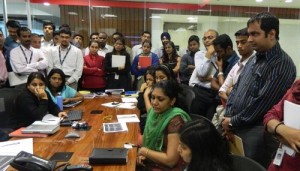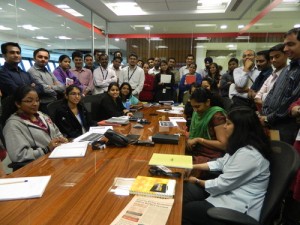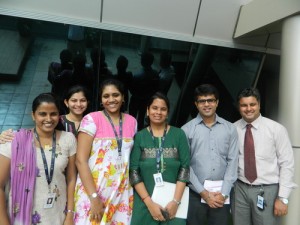We are glad to share this unique experience of JLT Group in exploring Social Learning and Thanks to Sunder Ramachandran, Senior Training Manager with JLT Group, for joining our writers panel and contributing this article here!
JLT Group is one of the world’s largest providers of insurance and employee benefits related advice, brokerage and associated services including an office of over 850 employees in Mumbai, India
To focus and grow in specialist areas, JLT partners with Chartered Insurance Institute (CII) to enhance the knowledge of its workforce and drive specialism (a key JLT strategy).
Social Learning @ JLT India
A cohort of 41 employees from JLT India was preparing for various CII professional exams scheduled in May 2013. This included various insurance related exams leading to the acquisition of globally recognised qualifications from CII like “Certificate in insurance”, “Diploma in Insurance” and “Advanced Diploma in Insurance”. This cohort engaged in social learning over an 8 week period to achieve exam success.
As a training team, it was becoming increasingly clear how employees are hooked on to the virtual world. Social networking, micro blogging, YouTube videos for learning were all realities that employees were embracing in their personal learning space. Our goal was to use the same engagement principles and support these students to prepare for their professional qualifications.
Social learning involves participating with others to make sense of new ideas using technology platforms. To this goal, we used chatter (our enterprise network) to provide these engagement opportunities to all the learners. The following were the key mechanics of this engagement:
Communities of practice: We created a CII exam community on our internal social platform. This became the epicentre of all discussions pertaining to the exams. Participants were encouraged to share tips, answer questions and also post updates on their own progress. The training team watched from the side-lines and moderated where required. The discussions were facilitated by CII certified peers. It was amazing how peer to peer information sharing and learning was adding speed to the knowledge acquisition process. The group was “learning at will” by getting questions answered at their workstations.
Off-line meets: A strong sense of ownership led to the offline meets. Participants met once every week for 60 minutes to discuss key learning’s and updates. Any key points made on the online forum that involved further deliberation were brought up in the offline meets. This was also an opportunity for senior managers to engage the participants which further encouraged them to succeed at the exams. This enabled us to blend synchronous and asynchronous methods of learning.
Chatter-thons: We used the widely popular tweetathon concept (used on twitter) and launched chatterthon. Each week, a topic of importance was picked up and live chat sessions were organised within the online community to drive engagement. The learners responded well and usually over a dozen questions were answered in a 30 minute slot (which is difficult to achieve if done in an offline classroom environment).
Gamification through Fastest Finger First– Gamification at it’s simplest involves ‘using game mechanics’ within a learning intervention i.e. leader boards, rewards, competition etc. This helps engage the learner and keep him motivated to learn more in an engaging way.To achieve this, contests were launched within the online community. The focus was on the ability of the learners to provide correct answers with speed (an important exam skill as well). A list of questions was prepared and all the participants were invited to be a part of these online events. Learners providing the fastest correct answer were rewarded. As the activity kicked off, the response was absolutely overwhelming and we were elated to see participants answering questions with the spirit of competition. The winners were rewarded with goodies.
Results achieved
We saw an evident change to the idea of how learning gets delivered and achieved an overall success rate of 83% in the CII exams. This was also the largest cohort of successful students from JLT India (34 successful candidates in May 2013).
(Some successful candidates who achieved the Cert CII qualification in May 2013)
Social was clearly the most pragmatic and effective way to ensure that participants take ownership and engage in peer to peer learning. The key benefits of social learning were:
- Improved knowledge sharing
- Fostered collaboration (Also a core JLT value)
- Provided informal learning opportunities
- Ease of finding resources & relationship building
 Sunder Ramachandran is a highly energetic training leader with extensive experience in building capabilities for large teams in the offshore/outsourcing space. He is currently a Senior Training Manager with JLT Group.
Sunder Ramachandran is a highly energetic training leader with extensive experience in building capabilities for large teams in the offshore/outsourcing space. He is currently a Senior Training Manager with JLT Group.
Sunder’s articles on workplace learning have appeared in Indian & International media including The Economic Times, Hindu Business Line, Times Ascent, National HRD Newsletter, Rediff.com, Askmen.com, Top7business.com, Human Capital and HrmAsia.com. His articles can be read at http://www.scoop.it/t/learning-leader. He is passionate about social learning and blogs on the learning experiments that he is leading at http://sundertrg.tumblr.com. Connect with him on LinkedIn and on twitter @sundertrg






0 Comments
You can be the first one to leave a comment.